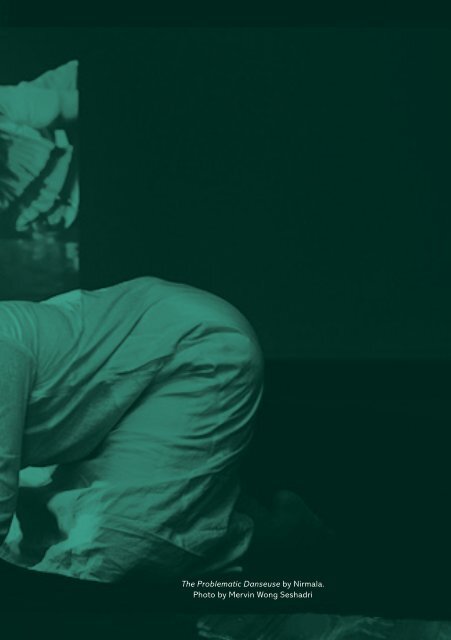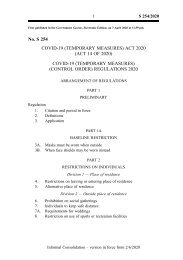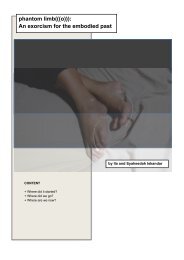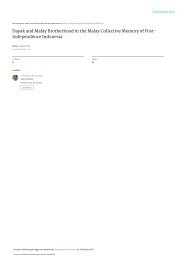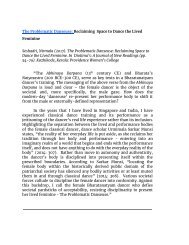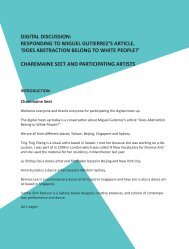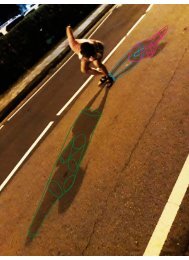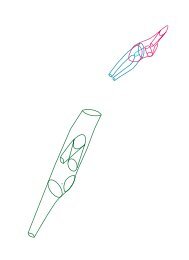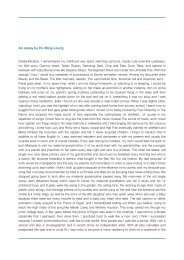FUSE#5
This edition of FUSE consists of articles contributed by artists who participated in Dance Nucleus' programmes in 2020.
This edition of FUSE consists of articles contributed by artists who participated in Dance Nucleus' programmes in 2020.
Create successful ePaper yourself
Turn your PDF publications into a flip-book with our unique Google optimized e-Paper software.
FUSE #5<br />
inspired to push the boundaries of my expression to reflect my personal<br />
interpretation of the poem as well as my authentic experience<br />
as a woman.<br />
As the piece progressed in its intensity, the final pose saw me in<br />
a supine position and with both my legs raised to depict heightened<br />
sexual enjoyment, laced with suggestions of autoeroticism. To my surprise,<br />
my lighting designer dimmed the lights prematurely leaving me<br />
to complete the piece in darkness, contradicting what was originally<br />
planned. Later he told me that he had made the decision to shield me<br />
from the audience gaze, given what he had understood of the general<br />
mindset, thus censoring me based on his own cultural viewpoint. An<br />
audience member told me that a group of young girls looked visibly<br />
uncomfortable and stood up to leave the auditorium. Appearing curious<br />
at the same time, they waited at the door, until the end. Later one<br />
of my key musicians commented that my rendition of the ashtapadi<br />
was “too erotic”. These reactions suggest to me that I had crossed a<br />
line in terms of the expression of sringara (erotic love).<br />
After the 2008 Singapore staging of the same performance,<br />
the contemporary artists and some general audience members were<br />
openly appreciative of my solo piece, but the Bharatanatyam community<br />
offered me little feedback. It is plausible to read their lack<br />
of feedback as a negative response, given the usual sharing that<br />
takes place among them on social media after any performance. This<br />
reading gains even more credibility when seen against the fact that<br />
these same students were not entirely silent about the performance<br />
as a whole—they expressed approval of my male collaborator's dance,<br />
while remaining silent about mine. Underscoring my reading of the silence<br />
as critique was a note I received from a Singapore-based female<br />
dancer and scholar who referred to my piece as “a big bold step<br />
which requires tremendous courage on your part…”. Her comment<br />
about courage was mirrored—albeit in a less laudatory manner—in a<br />
question posed to me in 2015 by a male interviewer from an established<br />
Indian arts organization in Singapore (Institution 1): “People say<br />
your dance is too erotic?” In general, the reactions emphasized that<br />
the mainstream Bharatanatyam community does not welcome these<br />
explorations in sensual expression. Even for the female dancer and<br />
scholar who was open to the work, there was a recognition that it<br />
demanded “tremendous courage”.<br />
Another production that evoked such recognition was the 2008<br />
staging of my dance theatre work Outcaste Eternal (1999) in Chennai<br />
that highlighted the true story of a lone woman’s battle against a misogynistic<br />
society. In their post-show communications with me, two<br />
leading dancers in the field had also used the words “brave” and<br />
111


